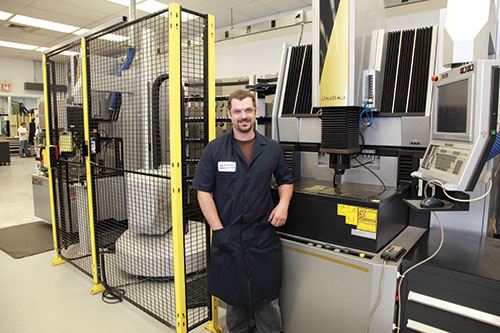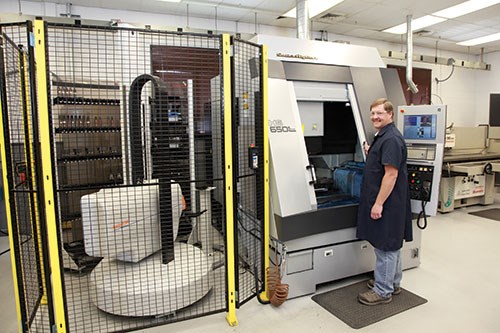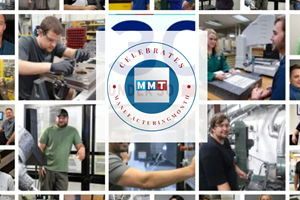Traditional Labor Values Meet Linear Technology
What GW gained was high reliability, improved speed/throughput without sacrificing accuracy or quality and a high level of satisfaction from the operators, on all the machines.
GW Plastics (Bethel, VT)—a global leader in plastic injection molding and contract manufacturing offering in-house mold design and build—was looking to become more competitive when working on multi-cavity molds and also wanted to decrease sinker EDM and bench polishing operations. This set off their search for the right technology solution.
A Rich History of Growth
With its world headquarters located in the picturesque Green Mountains of Vermont, GW Plastics has built a reputation as one of the industry’s most respected precision injection molding and contract manufacturing companies. GW’s focus is on injection molding, tooling and contract manufacturing of precision thermoplastic and silicone assemblies (and components) for the healthcare, automotive, consumer and industrial markets—all these markets being safety critical. GW excels at close-tolerance mold building, injection molding and contract assembly with a matrix of competencies geared toward innovative problem solving, Six Sigma quality, speed-to-market and global manufacturing.
GW Plastics was founded more than a half-century ago when two early plastics pioneers, John R. Galvin and Odin A. Westgaard, decided to combine their extensive business and materials engineering experience—and their initials—to start a plastics injection molding firm. After building GW into one of North America’s premier precision injection molders, they sold the company to Carborundum in 1973. After a series of large-company M&A transactions in the 1980s, GW ultimately found itself owned by Standard Oil of Ohio (Sohio). In 1983, a group of the company’s managers and investors led by Frederic Riehl purchased GW Plastics from Sohio. GW has remained closely-held, under the same ownership to this day. In 1998, Brenan Riehl became President and CEO after a successful career with Owens-Illinois and General Electric assuring a successful leadership transition and continuity of ownership.
The 1990s ushered in a period of rapid growth for GW, driving significant expansion of the company’s manufacturing capabilities and its geographic reach across the U.S. In 1990, GW relocated and expanded its moldmaking facility to a new Technical Campus in Royalton, VT. In 1992, GW expanded into the Southwest opening a new facility in San Antonio, TX; followed by a new plant in Tucson, AZ in 1996. GW further expanded its Royalton Technical Campus by opening a Technology Center dedicated to statistical mold qualification and new technology development in 1997, and by establishing its Royalton, Vermont Medical Molding facility in 1999.
In 2007, GW expanded globally—simultaneously into two hemispheres—by adding facilities in both Mexico and China. In 2008, GW announced its entrance into the Liquid Silicone market with GW Silicones in Royalton, VT. In 2012, in response to increased demand, GW completed an expansion of its GW Silicones operation at its Royalton, VT location.
With eight facilities operating from six locations worldwide, equipped with six class 8 cleanroom molding and assembly areas, GW has grown to a combined 350,000 square feet of environmentally-controlled injection molding, tooling and contract manufacturing space supplying market leading OEMs across the globe.
GW invests heavily in both salaried and hourly workforce training with a focus on quality to ensure its associates are trained in the latest technology and manufacturing techniques. GW accomplishes this through an in-house apprentice program and classroom training in partnership with local technical colleges to ensure an adequate supply of skilled personnel to support its growing needs.
GW is, consequently, seen as a preferred local and industry employer with a motivated workforce and exceptionally low turnover. Among senior management, the average term of employment is 20 years, salaried employees have an average tenure of 13 years, and hourly employees average eight years (a remarkable hourly seniority for a 24 x 7 manufacturer). GW currently has a large number of hourly and salaried employees with service between 20 and 50 years.
Technology Investment Proves Successful
GW realized in 2007 that they needed to improve their time frame from which they could bring a product to the market from the initial concept/design stage. They knew that speed to market was critical. They needed to purchase new, high technology machines to do so. GW was also looking to cultivate/train its labor force along the way.
GW evaluated its machining options, and decided that Sodick machines were the way to go to meet their goals. “GW Plastics is committed to continuously investing in precision tooling technology,” states Timothy Holmes, GW Plastics VP of Engineering.
“Over the past few years we have purchased a Sodick wire EDM, sinker EDM and high-speed mill,” he goes on to say. In 2010 GW first purchased the linear motor driven AG600L wire EDM and a few months later added the linear motor driven AG60L sinker EDM. They then added the linear motor driven HS650L high-speed mill in 2011. In 2012 GW decided to add an additional AG60L sinker EDM and integrate a System 3R Robot between the two sinkers.
The AG600L has an X, Y, Z travel of 23.62” x 15.75” x 13.78” (600 x 400 x 350 mm) and can accommodate a workpiece up to 2,204 lbs (1,000 kg). This wire EDM features linear technology and has a 10-year positioning accuracy guarantee. The AG60L has an X, Y, Z travel of 23.62” x 16.54” x 14.57” (600 x 420 x 370 mm) and can accommodate workpieces up to 3,307 lbs (1,500 kg). This sinker EDM is also linear motor driven and comes with a 10-year positioning accuracy guarantee.
The HS650L is Sodick’s high-speed mill that has linear motor drives and a 40,000 rpm spindle. The X, Y, Z travel is 24.41” x 19.69” x 11.81” (620 x 500 x 300 mm) and has a rapid feedrate of 1,417 ipm (36 m/min).
What GW gained was high reliability, improved speed/throughput without sacrificing accuracy or quality and a high level of satisfaction from the operators, on all the machines. GW’s technicians enjoy the friendly control, reliable threaded and decreased maintenance.
“This Sodick equipment has increased our throughput and machining accuracy, which is crucial to meeting speed-to-market requirements for the tight tolerance precision thermoplastic and silicone injection molds that we manufacture. The new equipment in our Royalton, VT Mold Division, in conjunction with our adjacent Technology Center where we immediately begin the GW Plastics scientific molding process development phase, provides us with a significant competitive advantage for new program launches,” stated Holmes.
GW was very impressed with Sodick Product Manager, Tom Hipp. While at IMTS a GW staff member saw the demonstration on the HS650L and was impressed with the surface finish that was achieved. He requested Hipp to come in for a follow up visit, after the IMTS 2012 show in Chicago.
With a strong engineering background, Hipp was able to work on their machine to even further improve their surface finish during his visit to GW. “GW wanted to achieve a 10.6 micro inches Ra surface finish on the HS650L,” states Hipp. “I went in and improved the process to achieve the requested surface finish and within a few hours they were up and running with their desired surface finish. They just needed a few tweaks with the CAD/CAM program they were running to reach the full potential of the HS650L,” Hipp adds.
GW has now become more competitive working on multi-cavity molds due to their two Sodick sinker EDMs and System 3R Robot; while the purchase of the Sodick HS650L high-speed mill has greatly decreased their sinker EDM and bench polishing operations.
They were also happy with the seamless installation, training and implementation that Sodick offered. Sodick Engineers were on hand to get the machines installed right away, and offered training so GW was up and running in no time. GW states that the “cultural fit” between the two companies made the process of installation and implementation much easier than expected.
GW Plastics, Inc.
(802) 234 9941
www.gwplastics.com
Related Content
Predictive Manufacturing Moves Mold Builder into Advanced Medical Component Manufacturing
From a hot rod hobby, medical molds and shop performance to technology extremes, key relationships and a growth strategy, it’s obvious details matter at Eden Tool.
Read MoreFrom Injection Mold Venting to Runnerless Micro Molds: MMT's Top-Viewed June Content
The MoldMaking Technology team has compiled a list of the top-viewed June content based on analytics. This month, we covered an array of topics including injection mold venting, business strategies and runnerless micro molds. Take a look at what you might have missed!
Read More30 Under 30: The New Face of Moldmaking
Young professionals are vital to the moldmaking industry, and it is important to acknowledge those making strides in shaping the industry's future. MoldMaking Technology recognizes the industry's young talent through its inaugural 30-Under-30 Honors Program.
Read MoreWomen Impacting Moldmaking
Honoring female makers, innovators and leaders who are influencing our industry's future.
Read MoreRead Next
Three EDM Warranty Considerations
Some factors to consider when purchasing a warranty program with your new EDM: price, benefits, time and preventive maintenance.
Read MoreHow to Use Continuing Education to Remain Competitive in Moldmaking
Continued training helps moldmakers make tooling decisions and properly use the latest cutting tool to efficiently machine high-quality molds.
Read MoreReasons to Use Fiber Lasers for Mold Cleaning
Fiber lasers offer a simplicity, speed, control and portability, minimizing mold cleaning risks.
Read More













_300x250 1.png;maxWidth=300;quality=90)



.jpg;maxWidth=300;quality=90)












.jpg;maxWidth=970;quality=90)